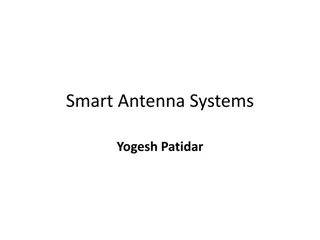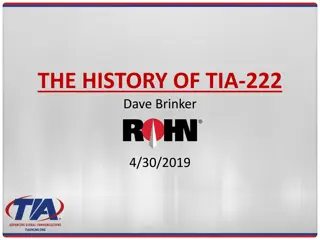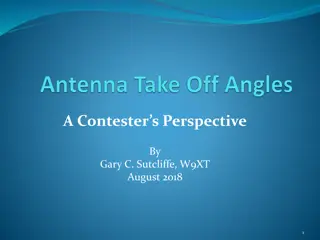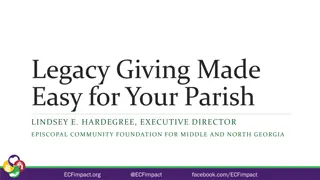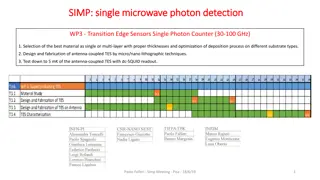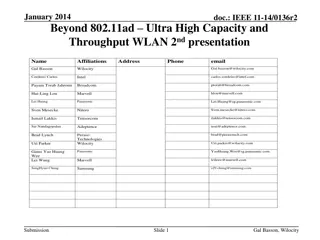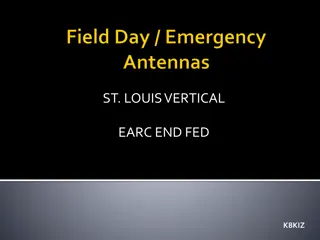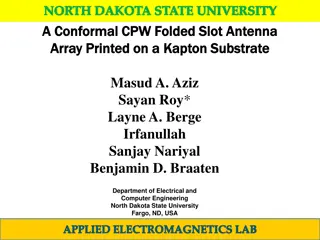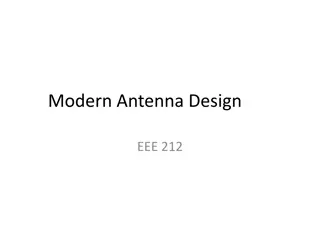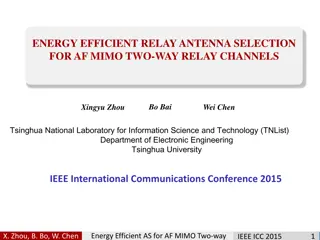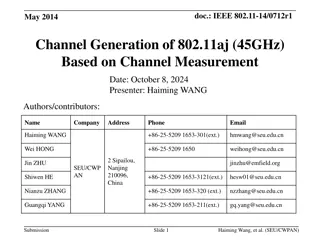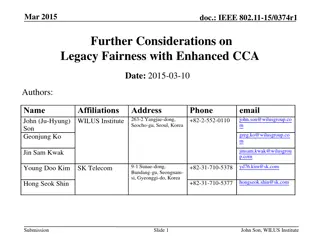Exploring Legacy BASIC Programming for Antenna Applications
Retired technician "KV0OOM" aka Mike, seeking new hobby in Legacy BASIC programming with various dialects like GW-BASIC, for working on antenna applications like loading coils, yagi beam pattern design, and more. Learn conversion options, tokenized file handling, and tools of choice for Windows systems.
Download Presentation

Please find below an Image/Link to download the presentation.
The content on the website is provided AS IS for your information and personal use only. It may not be sold, licensed, or shared on other websites without obtaining consent from the author. Download presentation by click this link. If you encounter any issues during the download, it is possible that the publisher has removed the file from their server.
E N D
Presentation Transcript
KV0OOM (aka Mike) RETIRED = Looking for a new hobby because 11 is not enuff. Technician + General on 18 Nov 2015 Extra on 08 Jan 2016 Not that smart, 5 years as a classroom instructor for electronics.
Many Dialects of BASIC Dartmoth Applesoft Sinclair Commodore BBC Liberty Microsoft GW-BASIC Texas Instruments PowerBasic QB64 QuickBasic https://en.m.wikipedia.org/basic BASICA Tiny
Many Dialects of BASIC Dartmoth Applesoft Sinclair Commodore BBC Liberty Microsoft GW-BASIC Texas Instruments PowerBasic QB64 QuickBasic https://en.m.wikipedia.org/basic BASICA Tiny
Legacy BASIC (GW-BASIC) IBM-PC Interpreted BASIC, used tokens (bytes) to store programs. A tokenized BASIC program is a text file, but is not Person readable. This was a form of pre-compile to improve execution speed.
Using Programs No issue if you copy or create a program and type it in yourself (sucks). ARRL Antenna Compendium Vol 2 & 3 Problem occurs when you get a text file tokenized (like from the Internet) and not person readable.
Legacy Program Applications I am primarily working with antennas: Loading Coils Coax Traps Phased Array Feeds Yagi Beam Pattern Design Polar Pattern Plotting Smith Chart Z Matching
Converson Options For Windows 10 DOSBOX = Run DOS pgms in a Window PC-BASIC Emulator GW-BASIC executable compiled for Windows Old PC running DOS 6.2 or Windows 3.1
Tokenized File Conversion If using a DOS or Win 3.1 computer, save the file (from GW-BASIC) using this command: SAVE FILENAME , A To save as a plaintext file.
Tools of Choice GWBASIC.EXE on a Win XP machine PowerBasic PBCC 4.04 command line compiler. PowerBasic started as Turbo Basic by Borlund Software.
Step by Step 1 1. Compile the file and check for errors. 2. If Error 484 (requires procedure), you must add Function PBMAIN or WINMAIN at the start, and END FUNCTION at the end. This is a WINDOWS requirement. 3. If LPT1, PRN, or LPRINT is in the code, you need to add or modify using XPRINT code because these are DOS commands:
Step by Step 2 ERRCLEAR XPRINT ATTACH DEFAULT IF ERR = 0 AND LEN(XPRINT$)>0 THEN XPRINT Printer working XPRINT FORMFEED These two lines should occur just XPRINT CLOSE before the program exits. ELSE INPUT No Windows printer found. ; ack$ END END IF
Step by Step 3 READ DATA takes the most work, most of the time, not counting error fixing READ T5$ (x-128) becomes T5$ = READ$ (X-128) String and Numeric data can be mixed in the same DATA line, but you have to be VERY careful forming the READs in the LOOP statement. Eventually, you will see, Compile succeeded at , but
Step by Step 4 YOU ARE NOT DONE. You still have to run the program. Double click or drag&drop on the EXE, it is a Windows program now.
Unfortunately The program filename parsing routines assumed the original 8.3 file name convention, which appear relevant when using file I/O operations. Also, you may encounter a program where the programmer is showing off his newly learned keywords. For example, he/she may use MID$() where LEFT$() was more appropriate. Decoding what they intended can sometimes be very interesting. This is where familiarity with BASIC comes in handy.
Quirks 1 Sometimes code does not work as expected, or desired. You have to decide if the effort to clean it up is worth it. Should you cut your losses and run? For me, it becomes personal. I like to think I am smarter than a glorified calculator.
Quirks 2 For example, I eventually discovered COMMAND$ returns the file path with quotes (I suspect because it contained a blank space) when using Windows drag & drop (drag the .BAS and drop it on the new EXE). I missed 2 clues with LEN and PRINT, and it cost me 15-16 hours of debugging.
Cut Your Losses and Run, Away The program was to convert tokenized BASIC to ASCII text. Once I got thru the file I/O issues, I learned the program was reporting token errors. I had already created an ASCII copy of the program. I knew the .BAS program was error free (token-wise) and knew what the output should be.
Project Tabled I may return to this project, but I know it will be a lot of work. 1. Locating the correct tokenization table for this version of BASIC. 2. Figuring out why the original programmer s code does not work. 3. Outsmarted is a coding issue. Aggravation is a programmer s code issue.
Pretend it Worked We added PBMAIN or WINMAIN. Next are those pesky LPRINT statements. LPRINT is a DOS function and we are in a Windows box. This means there will be some code edits required because DOS is deeply linked to the machine hardware. Windows is not.
LPRINT becomes XPRINT First, we must tell the program how to connect to the Windows printer: ERRCLEAR XPRINT ATTACH DEFAULT Then test for success IF ERR = 0 AND LEN (XPRINT$)>0 THEN XPRINT Printer working ELSE INPUT No Windows printer found. ; ack$ END END IF
Editing for Printer Output Now we are ready for the paper copy statements. If you change LPRINT or PRINT keywords to XPRINT, no other editing is normally needed. I prefer to convert the LPRINTs to XPRINTs, and make a second copy of the PRINT statements. I turn those into XPRINTs and edit for a pretty printout.
Reading DATA Revisited READ$ is a TEXT command. It is best to keep numeric DATA separate from string DATA. However, it is possible to read the data in groups of variables in each pass of the FOR-NEXT loop. Once I got away from TRS-80 Level II BASIC, I rarely used DATA statements, so my experience here is limited.
The Last Code Part These should be the last 3 lines of code if XPRINTing: XPRINT FORMFEED XPRINT CLOSE END FUNCTION Be sure to CLOSE the printer before ending the program.
GWBASIC.EXE If you need a copy of GW-BASIC, you can download it from here: https://hwiegman.home.xs4all.nl/gwbasit.html This is where I got my copy because Win XP did not include it.
More Links Detokenizers (Microsoft BASICs) Info http://edmond.orignac.pagesperso- orange.fr/detokenizer.html For Syntax: http://www.antonis.de/qbebooks/gwbasicman HEX editors: (UltraEdit and HdX) http://ultraedit.freedownloadscenter.com/windows/free https://mh-nexus.de/en/hxd/
HEX Editor? The HEX editor is a special tool for looking at files other than with a text editor. GW-BASIC tokenized files start with FF hex as the first byte in the file. If the file is protected , the first byte will be FE hex. And no , you cannot change the first byte to something else so you can unlock the file.
PEEK - POKE If you see either of these keywords in the code, FORGET IT. These commands are hardware specific and DOS connected. Windows does not allow random peeking and poking memory. You will get a memory violation or other dramatic end to your program. If you can t resist the need for speed, then learn Assembly Language for x86 processors. PowerBasic allows inline assembly embedded in the BASIC source code.
KV0OOM This project was initiated by obtaining some files authored by A. C. Buxton, W8NX. If you delve into coax chokes and traps, you will see this name a lot. kv0oom, Amateur Extra. kv0oom.extra@gmail.com Old, but not an Old Timer. Google is your best friend. RETIRED and hobby poor!
END Questions? Software demo is next





